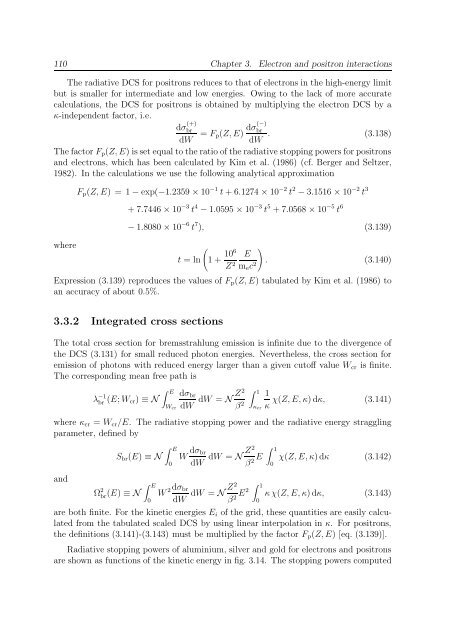PENELOPE 2003 - OECD Nuclear Energy Agency
PENELOPE 2003 - OECD Nuclear Energy Agency
PENELOPE 2003 - OECD Nuclear Energy Agency
You also want an ePaper? Increase the reach of your titles
YUMPU automatically turns print PDFs into web optimized ePapers that Google loves.
110 Chapter 3. Electron and positron interactions<br />
The radiative DCS for positrons reduces to that of electrons in the high-energy limit<br />
but is smaller for intermediate and low energies. Owing to the lack of more accurate<br />
calculations, the DCS for positrons is obtained by multiplying the electron DCS by a<br />
κ-independent factor, i.e.<br />
dσ (+)<br />
br<br />
= F p(Z, E) dσ(−) br<br />
dW . (3.138)<br />
dW<br />
The factor F p (Z, E) is set equal to the ratio of the radiative stopping powers for positrons<br />
and electrons, which has been calculated by Kim et al. (1986) (cf. Berger and Seltzer,<br />
1982). In the calculations we use the following analytical approximation<br />
where<br />
F p (Z, E) = 1 − exp(−1.2359 × 10 −1 t + 6.1274 × 10 −2 t 2 − 3.1516 × 10 −2 t 3<br />
+ 7.7446 × 10 −3 t 4 − 1.0595 × 10 −3 t 5 + 7.0568 × 10 −5 t 6<br />
− 1.8080 × 10 −6 t 7 ), (3.139)<br />
t = ln<br />
(<br />
1 + 106<br />
Z 2<br />
)<br />
E<br />
. (3.140)<br />
m e c 2<br />
Expression (3.139) reproduces the values of F p (Z, E) tabulated by Kim et al. (1986) to<br />
an accuracy of about 0.5%.<br />
3.3.2 Integrated cross sections<br />
The total cross section for bremsstrahlung emission is infinite due to the divergence of<br />
the DCS (3.131) for small reduced photon energies. Nevertheless, the cross section for<br />
emission of photons with reduced energy larger than a given cutoff value W cr is finite.<br />
The corresponding mean free path is<br />
∫ E<br />
∫<br />
λ −1<br />
br (E; W dσ br Z2 1 1<br />
cr) ≡ N dW = N χ(Z, E, κ) dκ, (3.141)<br />
W cr dW β 2 κ cr κ<br />
where κ cr = W cr /E. The radiative stopping power and the radiative energy straggling<br />
parameter, defined by<br />
and<br />
S br (E) ≡ N<br />
Ω 2 br (E) ≡ N ∫ E<br />
0<br />
∫ E<br />
0<br />
W 2 dσ br<br />
dW<br />
W dσ br<br />
dW<br />
∫<br />
Z2 1<br />
dW = N<br />
β E χ(Z, E, κ) dκ (3.142)<br />
2 0<br />
∫<br />
Z2 1<br />
dW = N<br />
β 2 E2 κ χ(Z, E, κ) dκ, (3.143)<br />
0<br />
are both finite. For the kinetic energies E i of the grid, these quantities are easily calculated<br />
from the tabulated scaled DCS by using linear interpolation in κ. For positrons,<br />
the definitions (3.141)-(3.143) must be multiplied by the factor F p (Z, E) [eq. (3.139)].<br />
Radiative stopping powers of aluminium, silver and gold for electrons and positrons<br />
are shown as functions of the kinetic energy in fig. 3.14. The stopping powers computed
















